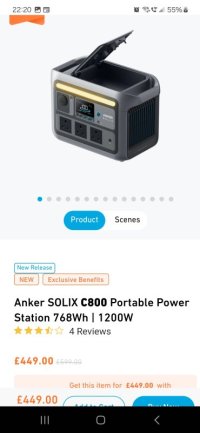Over the last couple of years I've followed @Dellmassive discuss power stations. I've just upgraded an old Allpowers unit to a newer Anker C800 plus, which i hope will perform better and be safer.
I have a T5.1 with a split charger to a 125ah agm battery, so the Anker supplements this.
However, as well documented, it's the issue of charging. In particular, when not away in the van we use the Allpowers and will use the Anker to power things at home to try and reduce electricity bills, charging them from solar or car DC 12v cigarette lighter socket.
What I want to do is charge the Anker more quickly when using my car for commuting to work. I've seen the other threads on the use of the orion DC-DC to up the voltage and then use the solar input.
However, I only want to use this system when I switch it on and NOT all the time, ie I don't want the alternator under load all the time, only when I want to charge the pack.
The car is stop-start, although I can turn the feature off and the battery is in the boot, which makes it easier to run short leads into the boot area etc.
So I appreciate that DC -AC - DC isn't a particularly efficient process but why can't I install a pure sine inverter straight from the car battery? If so, is there any inverter that is safe and reliable and comes with a remote switch, as I don't want it activated with ignition live and be on whenever the engine is running?
I thought this way I didn't have to worry about changing the voltage. I believe the alternator on the car puts out 220a, so would have thought a sensible inverter won't strain it too much.
I'm probably missing something important!
As plug and play and safe as possible so ideally I'm just bolting things together!
Thank you.
I have a T5.1 with a split charger to a 125ah agm battery, so the Anker supplements this.
However, as well documented, it's the issue of charging. In particular, when not away in the van we use the Allpowers and will use the Anker to power things at home to try and reduce electricity bills, charging them from solar or car DC 12v cigarette lighter socket.
What I want to do is charge the Anker more quickly when using my car for commuting to work. I've seen the other threads on the use of the orion DC-DC to up the voltage and then use the solar input.
However, I only want to use this system when I switch it on and NOT all the time, ie I don't want the alternator under load all the time, only when I want to charge the pack.
The car is stop-start, although I can turn the feature off and the battery is in the boot, which makes it easier to run short leads into the boot area etc.
So I appreciate that DC -AC - DC isn't a particularly efficient process but why can't I install a pure sine inverter straight from the car battery? If so, is there any inverter that is safe and reliable and comes with a remote switch, as I don't want it activated with ignition live and be on whenever the engine is running?
I thought this way I didn't have to worry about changing the voltage. I believe the alternator on the car puts out 220a, so would have thought a sensible inverter won't strain it too much.
I'm probably missing something important!
As plug and play and safe as possible so ideally I'm just bolting things together!
Thank you.


